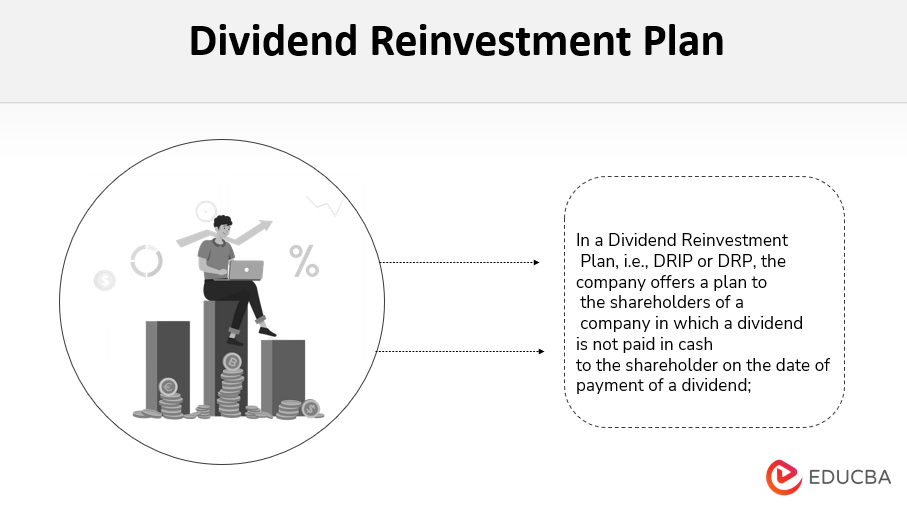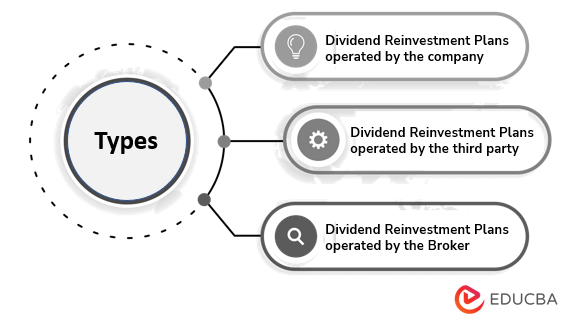Updated July 14, 2023
Definition of Dividend Reinvestment Plan
In a Dividend Reinvestment Plan, i.e., DRIP or DRP, the company offers a plan to the shareholders of a company in which a dividend is not paid in cash to the shareholder on the date of payment of a dividend; rather, the same is reinvested by the company in the additional shares of the company generally at a discounted price.
Explanation
When any company pays a dividend to its shareholder, then the shareholders receive that amount in their bank account, but in the case of the dividend reinvestment plan, existing investors or shareholders are provided with the option to invest their dividend amount in the share of that company instead of receiving the dividend in cash. These shares are generally available to investors at a discounted price. To acquire these shares from the company, shareholders either pay no commission or nominal charges. Generally, the company offers these plans to existing investors, but occasionally, the company may extend the same offer to new investors with a certain minimum amount.
Characteristics of Dividend Reinvestment Plan
Characteristics of the Dividend Reinvestment Plan are provided and discussed below:
- The program allows an investor to reinvest their dividend amount in additional company shares instead of receiving cash in return.
- In DRIP, the acquisition process occurs automatically, depriving investors of control over the acquisition time. If shares are acquired, the price can be either low or high.
- The holding of shareholders increases at a low cost.
How Does it Work?
The company pays dividends to the shareholder on its due date. The shareholders in their bank account receive this amount. But sometimes company offers a plan to the shareholders to invest this dividend amount in other new company shares. Investors or shareholders interested in increasing their investment in the company can go for this Dividend Reinvestment Plan. Generally, the company provides shares at a discount to the existing shareholder. These shares do not originate from the company’s reserves and not provide through exchanges. Here, the company kept complete and detailed records regarding the ownership percentage of shares.
Example of a Dividend Reinvestment Plan
Suppose Mrs. Grudge holds 2,000 shares in a company, and the dividend is payable at $ 20 per share. In between, the company offers the dividend Reinvestment plan to Mrs. Grudge, according to which, on the due date of the dividend, the dividend is reinvested into the shares of the company at a 20% discount where the market price of the share on the dividend date is $500 per share. Mrs. Grudge accepted the offer and participated in the plan. She has decided to invest a 100% dividend in this plan to enhance her investments in the company.
Analysis: On the due date of the dividend, she is eligible for a dividend amounting to $40,000 (2000 shares * $20), and as she participates in the plan, this dividend amount is invested in the shares of the company at a discount of 20% on the market price on the due date.
The reinvestment Rate is calculated as
- Reinvestment Rate = $500 per share – 20%* 500
- Reinvestment Rate = $500 – $100
- Reinvestment Rate = $ 400 per share
With this price, Mrs. Grudge now invests in extra shares of a company which is calculated as below:
- = Dividend Amount/ Reinvestment Rate
- = ($40000/$400 per share)
- = 100 shares
Thus, after reinvestment, she owns 2,100 (2,000+100) company shares. This process works in the same way.
Types of Dividend Reinvestment Plans
Dividend Reinvestment Plans are of three types that are provided and discussed below.
- Dividend Reinvestment Plans operated by the company –Here, the company operates its own plan and controls the functioning of the specific department dedicated to this plan.
- Dividend Reinvestment Plans operated by the third party – As the DRIP operated by the company is too expensive and time taking for the company, so company outsources the handling of this plan to the third party.
- Dividend Reinvestment Plans operated by the Broker –Here, the broker offers DRIP to the shareholders on certain investments, and the broker may charge a nominal commission for providing this service.
Best Dividend Reinvestment Plans
THE BEST DRIP in which the shareholder can invest is provided and discussed below:
- In Honeywell, the growth of dividends has been balanced and stable in past years.
- Johnson & Johnson is a high-yielding company, and the payout ratio is also increasing yearly.
- Emerson Electric manufactures industrial equipment that provide stable and increased dividends for the past 60 years.
- ExxonMobil has also increased the dividend payout constantly for many years.
- Abbvie Inc. has also increased the dividend payout constantly for many years.
- Kellogg Co is the strongest company in the payment of dividends if we compare it with other similar product-based companies.
Dividend Reinvestment Plan vs Growth Plan
In the growth plan, the company invests these profits nstead of paying a dividend to the shareholders from the company’s profits. Here the number of shares held by the shareholders remains the same, but the value of the share increases. It means the shareholders earn more value now from the same number of shares than they earn before this plan. But in the Dividend Reinvestment plan number of shares held by the shareholders increases as they get new shares in place of dividends.
Benefits of a Dividend Reinvestment Plan
The benefits of the dividend reinvestment plan are provided and discussed below:
- A dividend reinvestment plan is cost-effective for the shareholder as it offers shares at a discount and does not charge any commission for acquiring shares.
- It is beneficial for the investors as they get an increased return. In DRIP, a dividend is automatically reinvested into the company’s shares. At the time of payment of the next dividend, the shareholders also get the dividend on these extra shares received under DRIP. This process goes on, and the returns of shareholders increase.
- It is beneficial for the company as it gets shareholders for the long term because, generally, the shareholders with the intention of the long-term investment may opt for DRIP, and it also helps to raise capital for the company.
Disadvantages
Disadvantages of the dividend reinvestment plan are provided and discussed below:
- In DRIP, the acquisition process occurs automatically, giving investors no control over the timing of the acquisition. Shares are acquired even when the price is very high.
- By participating in DRIP, the investments of investors in one company increase. This will result in an undiversified portfolio.
- This plan is inappropriate for investors who want to make short-term investments in the company and depend on dividend income for their daily expenses.
Conclusion
Thus, the shareholders receive a dividend on their investments in the company on the due date of the dividend. But if the shareholders participate in DRIP, this dividend amount is not credited to their bank account. It automatically invests the dividend in new shares of the company at a discounted price. Either the company or a third party operates this DRIP. It is cost-effective for shareholders and beneficial for the company as it gets long-term investors, but it may also lead to an unbalanced portfolio of investors.
Recommended Articles
This is a guide to Dividend Reinvestment Plan. Here we discuss the definition and how dividend reinvestment plans work, along with benefits and disadvantages. You may also have a look at the following articles to learn more –





